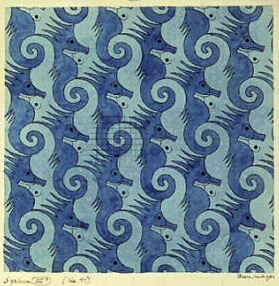Scribe Post #4
Tessellations
Learning Target: Identify different kinds of tessellations.
Vocabulary:
Vertex: The place in any tessellation where the shapes fit wella round a point. (The point is the vertex.)
Regular Tessellation: A tessellation that is only made of one polygon or shape.
Semi-regular Tessellation: A tessellation that has more than one type of regular polygon that has the same arrangement at every vertex.
Example: Tessellations that are made up of one polygon are called regular tessellations. (below) They are very simple to make. Its vertex measures are 360°.

This is a semi-regular tessellation, (below), because it uses two shapes: hexagons and triangles. It's angle measures are also 360°.

FOR A GROUP OF SHAPES THAT REPEAT TO BE A TESSELLATION, THE VERTEX INTERIOR ANGLES MUST BE 360°!!!! Because of that rule, pentagons, heptagons, and octogons will not work.
M. C. Escher creates tessellations with shapes. (Below) (Remember the "photo of the week" with the pictures of bats and angles?)

- »Permalink
- 2 Comments
- Posted by:Cambray
Nancy Drew
Nancy Drew

By Carolyn Keene
Nancy Drew is the world's all time best teen detective since 1930. She has sold over 200 million books in fourteen different languages. Since Nancy's mother died when she was young, she lives with her father and her loving housekeeper, Hannah. Nancy's father is a well-known and respected attorney. Often times, Carson needs his daughter's brilliant mind and clever schemes to crack his difficult cases. Along with Nancy, Bess and George, Nancy's best friends who happen to be cousins, also play a major role in Nancy Drew's famous stories. Although Nancy has been around for about 75 years, she still remains 16-18 years of age in each exciting mystery. There have been more modern versions of Nancy Drew written by people who have taken on the pseudonym that was created years ago by Edward Stratemeyer , but in my opinion, the old stories remain the best. Both men and women have used the pen name to keep Nancy Drew alive, and even better, she WILL be alive in the all new Nancy Drew movie.
There are many different Nancy Drew series to chose from...
Nancy has many different talents...
auto mechanics
cooking
horseback riding
dancing
sewing
athletics
and, (of course)
***solving mysteries***
- »Permalink
- 2 Comments
- Posted by:Cambray
Scribe Post #3

Learning Target: Estimate sums and differences with fractions.
Lesson: To estimate a sum, round the fraction first. (You would round it up if it is 1/2 or greater, and down if it was less.) Then estimate the sum.
To estimate a difference, round the fraction first. (You would round it up if the fraction is 1/2 or greater, and down if it was less.) Then estimate the difference.
Example: (Sum)
12 7/8
+ 15
~ 28
1. Round 7/8 up because it is more than 1/2. 2. Estimate the sum of the numbers.
Example: (Difference)
16 2/9
- 10
~6
1. Round 2/9 down because it is less than 1/2. 2. Estimate the difference of the numbers.
Links:
Estimating sums and differences with fractions
- »Permalink
- 1 Comments
- Posted by:Cambray
Scribe Post #2

Learning Target: Use stratagies to develop formulas to find the circumfrence.
What We Did: Each table was given five round items and we found the circumfrence and diameter of each of the items. When we divided the circumfrence by the diameter, our products were close to 3.14. That meant if you multiply the diameter by 3.14, or pi, you get the the circumfrence. Also, if you know the radious, then you can multiply that times four to get the circumfrence.
Example Problem: If the diameter is 4 inches, then you'd multiply it by 3.14, or pi.
3.14
x 4
12.56
For more information, visit these websites:
- »Permalink
- 1 Comments
- Posted by:Cambray




